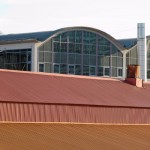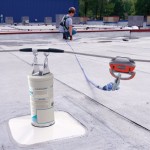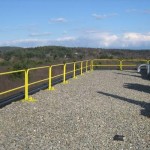Rooftop Fall Protection – 3 Essential Methods For Protecting Workers
 Rooftop fall protection is a necessity for keeping your workers safe while they perform tasks atop buildings. OSHA 1926.501(b)(1) states: “Unprotected sides and edges. Each employee on a walking/working surface (horizontal and vertical surface) with an unprotected side or edge which is 6 feet (1.8 m) or more above a lower level shall be protected from falling by the use of guardrail systems, safety net systems, or personal fall arrest systems.”
Rooftop fall protection is a necessity for keeping your workers safe while they perform tasks atop buildings. OSHA 1926.501(b)(1) states: “Unprotected sides and edges. Each employee on a walking/working surface (horizontal and vertical surface) with an unprotected side or edge which is 6 feet (1.8 m) or more above a lower level shall be protected from falling by the use of guardrail systems, safety net systems, or personal fall arrest systems.”
These are some of the more typical fall hazards that need to be guarded:
- Edges – This is the most obvious hazard.
- Skylights – Skylights are considered holes unless they’re guarded properly.
- Hatches – same as skylights
- Multi-Level Roofs – If there is a drop of six feet or more between two connecting surfaces, the edge of that drop must be guarded.
Rooftop safety requires special measures to prevent dangerous and potentially fatal accidents. The following are the three most common ways to provide fall protection for your employees.
Single-Point Anchors
Single-point anchors are used as fixed fall protection systems, allowing your employees and contractors to tie off to a single point. Cost-effective and simple to set up, single-point anchors are ideal solutions for clearly designated work areas.
Generally, single-point anchors are used for a single function that is limited in scope, such as the maintenance of an air-conditioning unit. A person is limited in movement and contained to an isolated tie-off point, keeping them safe while they perform the work.
Horizontal Cable Lifeline
 Like a single-point anchor, a horizontal cable lifeline is a fall protection solution that allows for a worker to be tied off and kept free from injury or death in case of a fall. With a horizontal cable lifeline, mobility and travel are much greater than with a single-point anchor.
Like a single-point anchor, a horizontal cable lifeline is a fall protection solution that allows for a worker to be tied off and kept free from injury or death in case of a fall. With a horizontal cable lifeline, mobility and travel are much greater than with a single-point anchor.
If designed correctly, a horizontal cable lifeline allows workers to move around an area with continuous 100% tie-off via the use of pass-through brackets. These fall protection systems are advantageous for any worker who needs to access multiple areas and be tied off the entire time.
Another reason to use a horizontal cable lifeline versus a guardrail system is to protect employees or contractors who are at risk of falling through a void in a structurally deficient roof. Guardrails, while generally favored for flat or low slope roofs, only work for perimeter protection.
Guardrails
 Guardrails are a generally accepted fall protection solution on rooftops and are favored in many cases because there is no need for worker training or PPE. This is usually the most cost-effective solution for the greatest coverage over a big area. There is no need for costly or potentially problematic roof penetrations, as non-penetrating guardrail systems are now a viable option.
Guardrails are a generally accepted fall protection solution on rooftops and are favored in many cases because there is no need for worker training or PPE. This is usually the most cost-effective solution for the greatest coverage over a big area. There is no need for costly or potentially problematic roof penetrations, as non-penetrating guardrail systems are now a viable option.
Guardrail systems are a great solution for perimeters and edges, allowing your workers to access the majority of the roof without issue. However, there is no protection against falling through voids. Before beginning work, it’s important to conduct a survey to assess any existing fall hazards related to structural integrity.
With the right rooftop fall protection system in place, you are able to keep your workers both safe and productive.
Ready to learn more? Call us at the number below.

